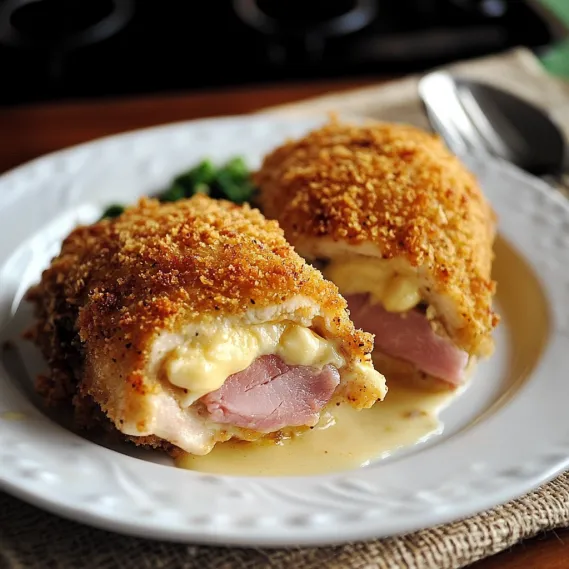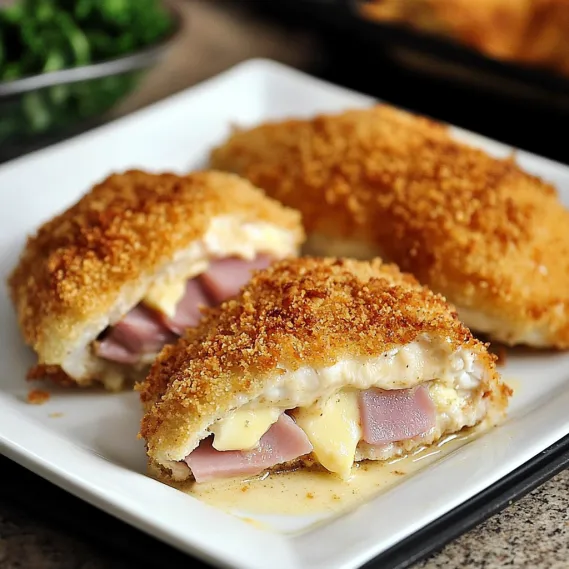 Pin it
Pin it
Tender chicken wrapped around smoky ham and melted Swiss cheese, all encased in a crispy golden crust - chicken cordon bleu is the epitome of elegant comfort food. For years, I struggled with this classic dish, ending up with cheese eruptions and chicken secured with dozens of toothpicks. The breakthrough came when I discovered a technique that revolutionized my approach: creating a simple pocket in the chicken and tucking in rolled ham and cheese. This method delivers perfectly sealed, beautifully presented cordon bleu every time, with the cheese staying exactly where it belongs - melted gloriously inside the juicy chicken.
Last weekend, I served this for a small dinner gathering, and my guests couldn't believe it was homemade. My husband, who typically requests simple grilled chicken, now asks for this cordon bleu regularly. The transformation from my previous attempts to this foolproof method has made all the difference.
Essential Ingredients and Selection Tips
- Chicken Breasts: Choose thick, even-sized boneless breasts that will be easier to cut pockets into without breaking through. Look for breasts that are around 6-8 ounces each for perfect portion sizes
- Swiss Cheese: Opt for high-quality Swiss that melts well. I prefer shredding it myself rather than using pre-shredded, as it melts more smoothly and has better flavor. The nuttiness of a good Emmental or Gruyère adds wonderful depth
- Ham: Thin-sliced, good quality deli ham works perfectly. I prefer a smoky variety that adds another dimension of flavor. Make sure the slices are intact, not torn, for easier rolling
- Breadcrumb Mixture: Combining panko breadcrumbs with crushed butter crackers creates the perfect texture – crispy yet substantial. This dual-crumb approach elevates the crust beyond basic breaded chicken
When shopping for these ingredients, quality matters more than you might think. The first time I made this with premium Swiss cheese instead of the budget variety, the difference in flavor was remarkable - that rich, nutty taste transformed the entire dish.
Detailed Cooking Instructions
- Step 1: Prepare the Filling
- Shred the Swiss cheese finely and divide it into equal portions based on the number of chicken breasts. Layer thin slices of ham on a cutting board, slightly overlapping each piece, and spread cheese across the center. Roll the ham around the cheese into tight cylinders, creating neat packets that will fit inside the chicken pockets.
- Step 2: Create Chicken Pockets
- Place each chicken breast on a cutting board and, using a sharp knife, cut a horizontal pocket along the thickest side, being careful not to slice all the way through. The pocket should be deep enough to hold the ham-cheese roll but with enough chicken intact to seal it closed. Season the inside of each pocket with salt and pepper before filling.
- Step 3: Fill and Secure Chicken
- Gently insert a ham-cheese roll into each chicken pocket, pushing it all the way in while keeping the opening as small as possible. If needed, secure the opening with 1-2 toothpicks placed parallel to the opening. Brush the entire chicken breast with beaten egg and press firmly into the breadcrumb mixture, ensuring all surfaces are evenly coated.
- Step 4: Baking Preparation
- Place the breaded chicken on a wire rack set over a baking sheet, which allows air to circulate and creates an evenly crispy exterior. Lightly spray or drizzle the breaded chicken with melted butter, which helps achieve that beautiful golden-brown color. Preheat your oven to 375°F to ensure it's fully heated before the chicken goes in.
- Step 5: Baking and Resting
- Bake the chicken for 25-30 minutes until the internal temperature reaches 165°F and the breadcrumb coating is crispy and golden. Allow the chicken to rest for 5 minutes before serving, which gives the juices time to redistribute throughout the meat and prevents the cheese from oozing out when cut. Remove any toothpicks before serving.
 Pin it
Pin it
When I first served this cordon bleu to my family, my daughter couldn't believe it was the same dish that had previously caused so much frustration in our kitchen. The look of delight on her face as she cut into perfectly sealed chicken with melted cheese inside was worth every minute of perfecting this technique.
The Secret to Perfect Crust
The crunchy exterior is what makes chicken cordon bleu truly special. I've found that combining panko breadcrumbs with crushed butter crackers creates the perfect texture. The crackers add richness and golden color, while the panko provides that satisfying crunch. I season this mixture generously with garlic powder, paprika, and a touch of thyme to complement the ham and cheese. This attention to the crust transforms what could be ordinary breaded chicken into something memorable.
 Pin it
Pin it
Managing Cooking Temperature
After numerous attempts, I've found that moderate heat for a longer time works better than high heat for this dish. The chicken cooks through evenly while allowing the cheese to melt without overheating and separating. Starting in a 375°F oven and not rushing the process ensures juicy chicken and perfectly melted cheese. If your chicken breasts are particularly thick, you might need to add a few extra minutes, but always use a meat thermometer to confirm doneness without cutting into the meat and releasing those precious juices.
Serving Suggestions
Chicken cordon bleu pairs beautifully with lighter sides that balance its richness. I love serving it with a bright lemon-dressed arugula salad, roasted asparagus, or buttery green beans. For a heartier meal, creamy mashed potatoes or wild rice make excellent companions. A light dijon cream sauce drizzled over the top can elevate this dish for special occasions. The contrast between the crispy chicken exterior and a smooth, tangy sauce creates a restaurant-worthy presentation that never fails to impress guests.
Make-Ahead Options
One of the best features of this recipe is how well it works for meal prep. I often prepare the chicken through the breading stage, then refrigerate it for up to 24 hours before baking. This actually improves the flavor as the seasonings have time to penetrate the meat. You can also freeze the breaded, uncooked chicken for up to a month - just thaw overnight in the refrigerator before baking. This makes it perfect for busy weeknights when you want something special without the last-minute preparation.
 Pin it
Pin it
My journey with chicken cordon bleu reflects how cooking is often about finding smarter techniques rather than working harder. What once caused kitchen stress is now one of my signature dishes that brings everyone to the table with anticipation. The pocket method has transformed this classic from a special occasion challenge to an achievable weeknight luxury. Each time I make it, I'm reminded that sometimes the most satisfying cooking victories come from rethinking traditional approaches rather than following them blindly.
Frequently Asked Questions
- → Can I prepare Chicken Cordon Bleu ahead of time?
- Yes! This recipe is great for make-ahead preparation. You can stuff and bread the chicken up to 24 hours before cooking. Simply prepare the recipe through the breading step, then cover the breaded chicken tightly and refrigerate. When ready to cook, place the cold chicken directly in the preheated oven, though you may need to add 5-10 minutes to the baking time since the chicken will be cold from the refrigerator.
- → How do I know when my Chicken Cordon Bleu is done cooking?
- The most reliable way to check for doneness is using an instant-read thermometer inserted into the thickest part of the chicken (not the filling). The chicken is done when it reaches 160°F - it will rise to the safe temperature of 165°F while resting. If you don't have a thermometer, cut into the thickest part of one piece; the meat should be opaque with no pink remaining, and the juices should run clear.
- → What can I serve with Chicken Cordon Bleu?
- This elegant main dish pairs well with many sides. For starches, consider mashed potatoes, rice pilaf, or buttered egg noodles. For vegetables, roasted asparagus, green beans, or a simple green salad work beautifully. A light dijon cream sauce drizzled over the top is also a classic accompaniment that complements the flavors of the dish perfectly.
- → Can I use different cheeses or meats in this recipe?
- Absolutely! While Swiss cheese and ham are traditional, you can customize with other combinations. Try provolone, mozzarella, or Gruyère cheese. For meats, prosciutto offers a more gourmet touch, or turkey ham for a lighter option. Just make sure whatever cheese you choose melts well, and that the meat is thinly sliced so it rolls easily with the cheese.
- → Why do I need to refrigerate the stuffed chicken before breading?
- Refrigerating the stuffed chicken for at least 20 minutes helps the chicken hold its shape and keeps the filling from leaking out during the breading process. This brief chilling time firms up the chicken and helps the pocket stay closed. If you're short on time, you can skip this step, but be extra careful when handling the chicken during breading.
- → Can I make this recipe gluten-free?
- Yes, this recipe can be adapted to be gluten-free. Use gluten-free crackers instead of Ritz, gluten-free bread for the crumbs, and replace the all-purpose flour with a gluten-free flour blend. Also, verify that your deli ham is gluten-free, as some processed meats contain gluten-based additives. With these substitutions, you can enjoy this classic dish while maintaining a gluten-free diet.
